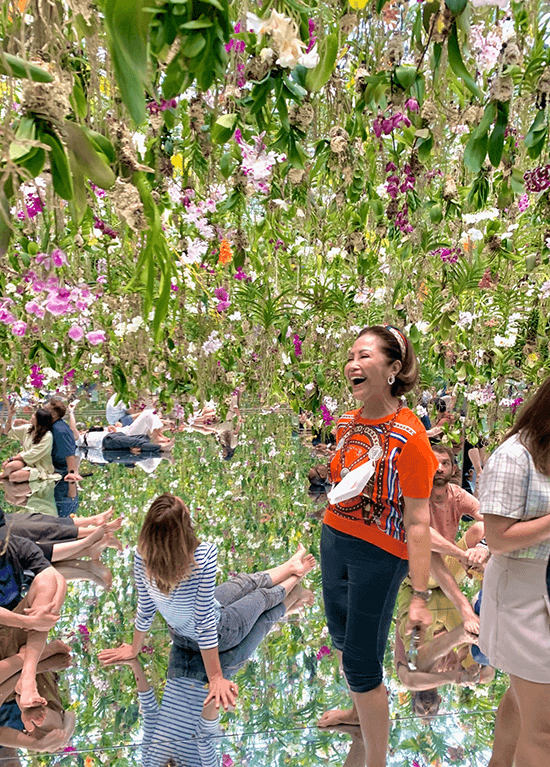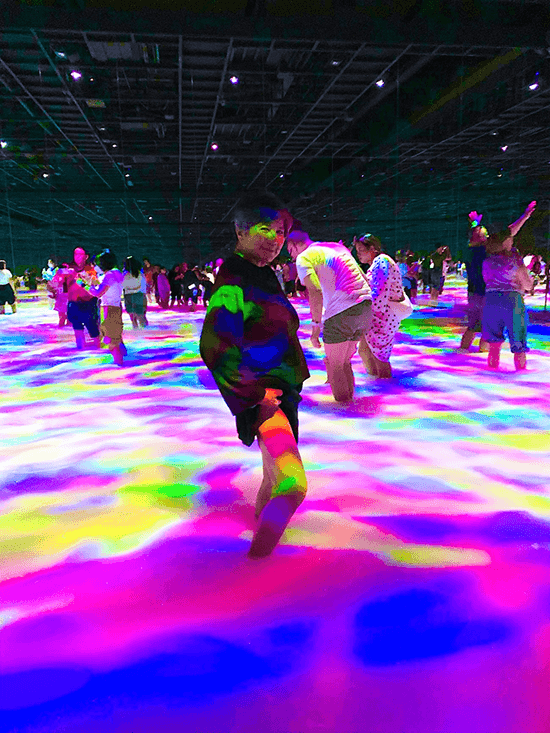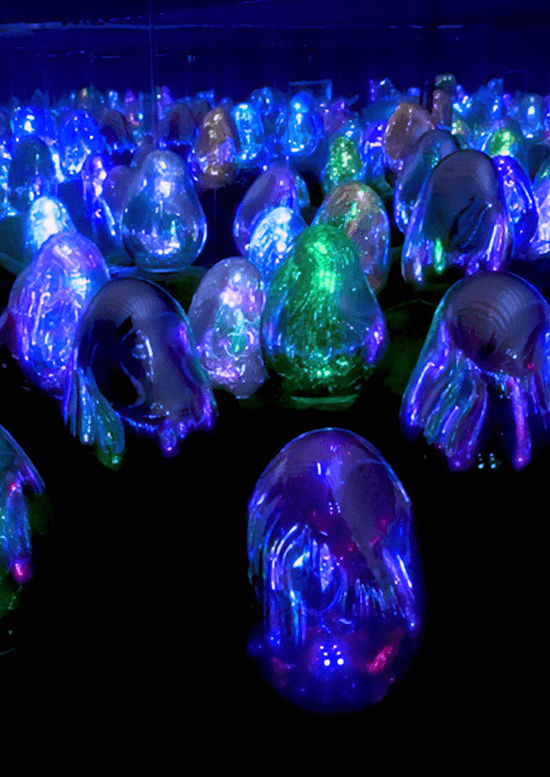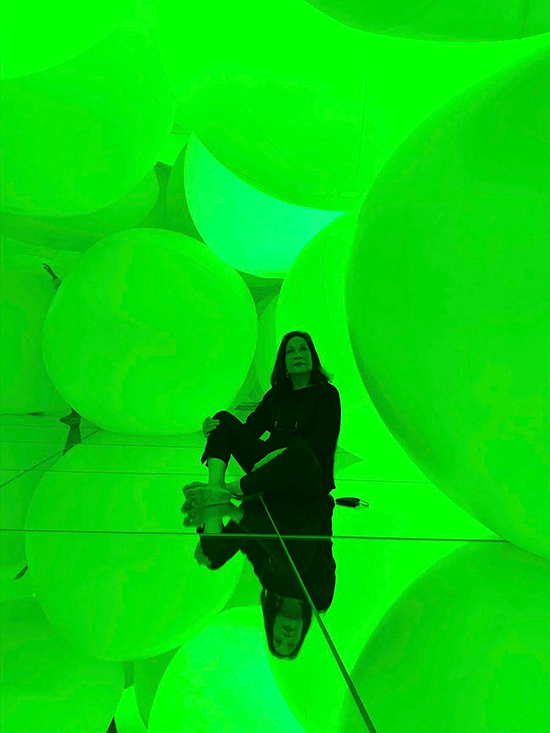Into a world of dreams and color
Tokyo captivates the senses, inundating me with a torrent of thoughts and words brimming with excitement. The city's allure lies in its remarkable fusion of ancient traditions and ultra-modern marvels—a harmonious coexistence rarely witnessed in our 21st-century lives. Tokyo is truly a world of its own.
Since the early 1990s, the colossal moving advertising boards adorning the facades of buildings in Ginza have made digital art a norm. It was here that I first recognized the extraordinary possibilities that lay in this realm. However, it wasn't until 2007 that I stumbled upon Yoko Ono's awe-inspiring light sculpture, Imagine Peace Tower—a heartfelt tribute to John Lennon. What struck me the most was not just the sheer brilliance of her concept, but also the remarkable engineering that underpinned it. Nestled in Reykjavik, Iceland, the sculpture relies on geothermal energy, aligning with an environmentally responsible plan to illuminate it during specific times of the year. Being aware of this innovative masterpiece, I became certain that even more groundbreaking digital light projections would emerge in the future.

At times, I would stumble upon captivating stage shows while flipping through TV channels, marveling at the magnificent panoramic videos unfolding behind and above the performers. These breathtaking visual spectacles, some of which graced America's Got Talent and its affiliated programs, left me in awe. Perhaps due to my background in theater design, I found myself engrossed in the captivating world that unfolded on stage, often overshadowing the performers themselves. The art of projecting illuminated forms and vibrant colors constantly evolves, introducing new dimensions of creativity.

On the flight back from Europe in 2019, I came across an article that introduced me to the enigmatic figure of Toshiyuki Inoko. Etched into my memory was the image of a young and handsome Japanese man, his mischievous gaze setting him apart. I found it refreshing, as most distinguished Japanese individuals exude formality when captured in photographs for features. The article described him as a former school prankster, but his current descriptor had transformed into "genius in digital engineering." This transformation left an indelible impression on my mind, fueling my curiosity about his remarkable journey.

Many things happened since then and those dual feelings of wonder and worry about the advancement of visual stimuli through technology remained at odds with each other. I appreciate the quality-of-life improvements that technological advancement has given us but I am also concerned about what might transpire if we rely on it too much. I am a curious soul more than anything, and I truly wanted to see how these ideas unfold firsthand. I want to witness the manifestation of these ideas in all its shapes and forms.
It was during the pandemic that I realized my bucket list still had a few more places and destinations around the world that I yearned to visit once the crisis subsided—these included spots that have fascinated me so much since learning about them.

Among these are the amazing installations by the TeamLab group, which I had seen in many photos and videos on the internet. I knew they were doing a lot of good work but, to my astonishment, Inoko san and company had experienced exponential growth, boasting a workforce of 700 employees with offices in both the United States and Europe. It was at that moment that a sudden urge compelled me to revisit the mesmerizing video of the Turandot opera in Geneva, and sure enough, it was his company that had collaborated on that groundbreaking, immersive opera production. Enthusiastically supported by my adventurous companions, we embarked on an unforgettable, interactive art excursion to the TeamLab Planets Museum in Tokyo. From wading barefoot through a path of rushing water that defied gravity, originating from a surreally magnificent waterfall cascading from a seemingly otherworldly black abyss, the experience was undeniably cool. While I initially thought that children would revel in this extraordinary display, the expressions of awe had yet to manifest on anyone's face.

Then, we ventured into an area that resembled a maze, with captivating lights emanating from every direction imaginable. The interplay of mirrors on the floor, walls, and ceiling created an infinite extension of these flickering lights, their colors synchronized with rhythmic music. In this enchanting spectacle, wherever your gaze landed, you became an integral part of the mesmerizing symphony of colored lights swirling around you, hypnotizing your senses.

Minutes later, we found ourselves immersed in water once again, this time at a depth of approximately two feet. A swarm of koi fish, varying in size, gracefully swam around us, creating an atmosphere that evoked the inner child in each of us. The simulated sounds of fish playfully gliding in and out of the water heightened the sensation—evoking emotions like that of a joyful child! Everyone was delightfully thrilled. Smiles and laughter permeated the surroundings, tempting us to linger longer, were it not for one of the museum guides who signaled the group that it was time to proceed to the next space.

We transitioned from the exhilarating realm of childlike play into a serene world adorned with three-dimensional balloons. These whimsical objects were scattered throughout the room, some floating atop one another. Crafted from thick, opaque plastic, they possessed a texture reminiscent of smooth marshmallows—soft to the touch but lacking the density to bounce. Upon contact, each balloon would undergo a gradual transformation, changing both in color and emitting a unique tone associated with that specific hue. The languid nature of this metamorphosis induced a profound sense of relaxation, almost lulling one into a state of peaceful drowsiness. As if in a gentle choreography, the balloons would subsequently shift their colors in unison, filling the room with a harmonious tone. The gradual and lethargic transition allowed for a slow progression of colors from one balloon to the next, inviting visitors to simply sit, unwind, and savor the meditative spectrum of hues.

Following a short pathway, we found ourselves in a captivating dome-shaped space known as the Floating Universe of Flowers. Here, one could easily imagine being immersed in a dream, carried away by the rustling sound of petals and blossoms of varying kinds and sizes. It evoked a sensation akin to existing within a beautiful, magical environment, reminiscent of a film portraying the experience of crossing over from this world to the next in such a stunning and enchanting setting.

The exhibit's numerous simulated effects captivated our senses, immersing us in a continuous state of engagement. However, upon reaching the Moss Garden, a wave of relief washed over me. The reflective ovoids in this open alcove were no longer mere illusions, but tangible objects enveloped by thriving moss and bathed in natural light. This transition from the purely visual and simulated realm to something we could touch and feel—embraced by living flora—had a profound impact. When caressed by hand or gently swayed by the breeze, they emitted enchanting sounds. Furthermore, these illuminated ovoids radiated a kaleidoscope of colors at night, transforming each touch into a mesmerizing spectacle.

Perhaps the most palpable experience within the entire exhibition was the Floating Flower Garden. As its name suggests, 13,000 live orchids suspended in mid-air swayed in a gentle up-and-down motion. Mirrors adorned every surface, including the floor and ceiling, creating an ethereal paradise of blossoms that felt otherworldly. One might wonder how to navigate through such a densely filled space of living orchids, but the area was equipped with human detection sensors that facilitated sections to lift or open up as visitors passed through. When no one was present, the orchids gracefully descended to their lowest point. Once surrounded by these vibrant blooms, it became impossible to discern where the garden began or ended. The air carried a gentle scent that subtly changed with the passing hours of the day.

The Moss Garden and the Floating Flower Garden served as a fitting conclusion to the 10,000-square-meter museum, for here, life itself thrived rather than being a synthetic spectacle. While the visual impact was striking and the entertainment undeniable, my mind was brimming with numerous questions.
With such immense creative power at the fingertips of Inoko-san and his team, they have the ability to transport virtual worlds across our field of vision, offering us a multitude of sensations and experiences that accompany the breathtaking compositions they create. This concept alone is already compelling, leading me to wonder about the profound impact this technology will have on us moving forward.

Throughout history, science has sought to emulate life, resulting in unforgettable instances in visual media such as motion pictures, animation, and even the interfaces of our handheld devices and computer wallpapers. The art born from these technological advancements has also benefited humanity in countless ways, from breakthroughs in diagnostic imaging to applications in medicine and the exploration of our natural world. The possibilities that lie ahead seem boundless.

I can only begin to fathom a fraction of the potential that TeamLab and other pioneering entities in this field hold for us in the future. While architectural landmarks have traditionally served as enduring symbols of awe and wonder, perhaps these fleeting moments of joy and excitement, represented by lights, butterflies, flowers, stars, and playful fish, can one day assume a form that not only captivates for a moment but also leaves within us a sense of unity, peace, and benevolence—a feeling that seems to have faded amidst the overwhelming influence of our modern age, characterized by separatism, materialism, noise, and self-centered pursuits.
It is no secret that I attribute many of these concerns and wonders I mentioned earlier to the rapid and all-encompassing pace at which technology has permeated every aspect of our lives. However, I am also filled with hope that, in the right hands, our future may shine as brightly as we had once envisioned.


